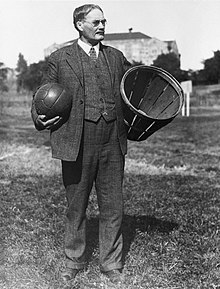Basketball at the 1948 Summer Olympics was the second appearance of the sport of basketball as an official Olympic medal event. A total number of 23 nations entered the competition.
Basketball at the 1952 Summer Olympics was the third appearance of the sport of basketball as an official Olympic medal event. 23 nations entered the competition.
Basketball at the 1960 Summer Olympics was the fifth appearance of the sport of basketball as an official Olympic medal event. 16 nations were admitted into the Olympic tournament, with many others being eliminated in a pre-Olympic tournament held earlier in the year from 13 to 20 August 1960 at the Land Rover Arena at Bologna. 64 games of basketball were played in the Olympic tournament that was held at the Palazzetto dello Sport and PalaLottomatica, both in Rome.
The 1934 FIFA World Cup was the first World Cup for which teams had to qualify, after the finalists in the inaugural 1930 World Cup had participated by invitation from FIFA. With 32 teams having entered the 1934 competition, FIFA organized qualification rounds to select 16 teams for the finals. Even Italy, the host of the World Cup, had to earn its spot, the only time this has been the case. The previous champion Uruguay refused to defend its title because many European nations had declined to take part in the 1930 World Cup, held in Uruguay.
A total of 37 teams entered the 1938 FIFA World Cup qualification rounds, competing for a total of 16 spots in the final tournament. For the first time the title holders and the host country were given automatic qualification. Therefore, France, as the hosts, and Italy, as the defending champions, qualified automatically, leaving 14 spots open for competition.

At the 1992 Summer Olympics in Barcelona, Spain, 31 swimming events were contested. There was a total of 641 participants from 92 countries competing.
The 2001 Fed Cup was the 39th edition of the most important competition between national teams in women's tennis.

The Latvia men's national basketball team represents Latvia in international basketball. They are organized and run by the Latvian Basketball Association. Latvia has reached the European Basketball Championship 15 times, with their ultimate success occurring during the inter-war period, when they became the first team to win the tournament in 1935. Four years later, they had another impressive run to come away with the silver in 1939. Although after 1939, Latvia were forced to suspend their national team operations, due to the Occupation of the Baltic states during World War II. Latvia regained independence in 1991, with their national team taking part in international competition once again a year later.

The Estonia men's national basketball team represents Estonia in international basketball matches. They are controlled by the Estonian Basketball Association. The team competed in their first international tournament at the 1936 Olympic Games. Estonia has also qualified for the EuroBasket six times overall, with their best results coming in 1937 and 1939. However, after 1939, Estonia halted national team activities due to the occupation of the Baltic states during World War II. Estonia would later rejoin FIBA in 1991, after regaining independence from the Soviet Union.

The Judo competition at the 1992 Summer Olympics was contested in fourteen weight classes, seven each for men and women. The seven men's weight classes continued to be those first used in 1980. This was the first Olympic competition to award medals to women judoka; women competed in 1988 as a demonstration sport.
The 1984 Federation Cup was the 22nd edition of the most important competition between national teams in women's tennis. The tournament was held at the Esporte Clube Pinheiros in São Paulo, Brazil, from 15 to 22 July. Czechoslovakia successfully defended their title, defeating Australia in the final.
The 1985 Federation Cup was the 23rd edition of the most important competition between national teams in women's tennis. The tournament was held at the Nagoya Green Tennis Club in Nagoya, Japan, from 6–14 October. Czechoslovakia defeated the United States in the final, giving Czechoslovakia their 4th and 3rd consecutive title.
The 1986 Federation Cup was the 24th edition of the most important competition between national teams in women's tennis. The tournament was held at I. Czech Lawn Tennis Club in Prague, Czechoslovakia, from 20 to 27 July. The United States defeated three-time defending champions Czechoslovakia in the final, giving the USA their 12th title. The finals marked Martina Navratilova's first return to Czechoslovakia since her defection to the United States in 1975.
The 1995 Fed Cup was the 33rd edition of the most important competition between national teams in women's tennis, and the first to bear the name Fed Cup.
The 1998 Fed Cup was the 36th edition of the most important competition between national teams in women's tennis. In the final, Spain defeated Switzerland at Palexpo Hall in Geneva, Switzerland on 19–20 September, giving Spain its fifth title.
Twenty-one men's teams competed in basketball at the 1936 Summer Olympics.
The 2011 Fed Cup was the 49th edition of the tournament between national teams in women's tennis.
The history of the FIBA Basketball World Cup began in 1950, with the first FIBA Basketball World Cup, which was the 1950 FIBA World Championship. The FIBA Basketball World Cup is an international basketball competition contested by the men's national teams of the members of the International Basketball Federation (FIBA), the sport's global governing body. The championship has been held every four years since the inaugural tournament in 1950.
The 1948 United States men's Olympic basketball team competed in the 1948 Summer Olympics, along with 22 other basketball teams. The basketball tournament was held in London, England at Wembley Stadium. Team USA won their second straight gold medal after 1936. The team was made up of Amateur Athletic Union and college basketball players.
The following is the list of squads for each of the 23 teams that competed in the 1948 Summer Olympics, held in United Kingdom between 30 July and 13 August 1948. Each team selected a squad of 12 players for the tournament.







